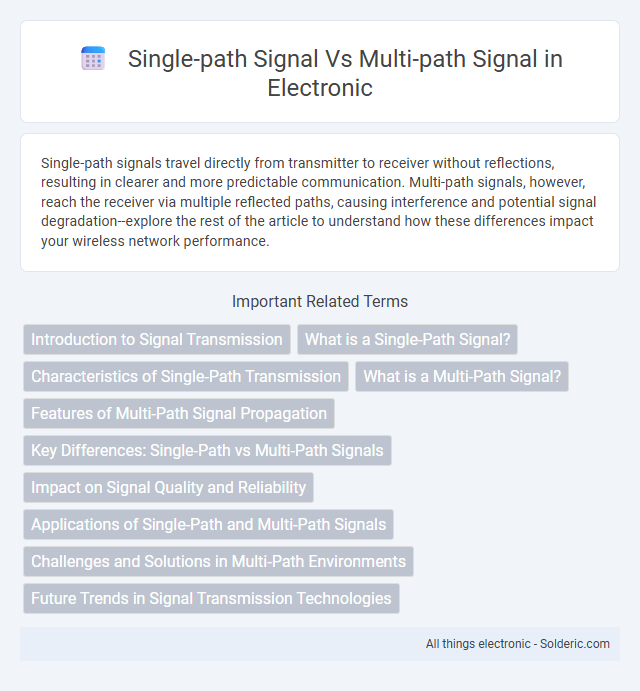Single-path signals travel directly from transmitter to receiver without reflections, resulting in clearer and more predictable communication. Multi-path signals, however, reach the receiver via multiple reflected paths, causing interference and potential signal degradation--explore the rest of the article to understand how these differences impact your wireless network performance.
Comparison Table
| Feature | Single-Path Signal | Multi-Path Signal |
|---|---|---|
| Definition | Signal travels through one direct path between transmitter and receiver. | Signal arrives via multiple paths due to reflection, diffraction, and scattering. |
| Signal Quality | Generally stable with minimal distortion. | Can cause fading, interference, and signal distortion. |
| Delay Spread | Minimal delay spread. | Significant delay spread due to multiple path lengths. |
| Impact on Communication | Improved clarity and lower error rates. | Increases bit errors and decreases communication reliability. |
| Common Environments | Open, line-of-sight channels. | Urban, indoor, and obstructed environments. |
| Mitigation Techniques | Rarely needed. | Diversity, equalization, RAKE receivers, MIMO technology. |
Introduction to Signal Transmission
Signal transmission involves the propagation of electromagnetic waves from a transmitter to a receiver, where single-path signals travel along a direct, unobstructed line of sight, minimizing delays and interference. Multi-path signals arise when transmitted waves reflect off surfaces like buildings or terrain, causing multiple signal copies to arrive at different times, which can lead to fading, distortion, or signal overlap. Understanding these transmission characteristics helps optimize Your wireless communication systems for reliability and performance in various environments.
What is a Single-Path Signal?
A single-path signal is a wireless communication signal that travels directly from the transmitter to the receiver without reflection or scattering, resulting in a clear and stable reception. This signal type minimizes interference and multipath fading, ensuring higher signal quality and reliability. Your communication system benefits from improved accuracy and reduced error rates when relying on single-path signals in line-of-sight conditions.
Characteristics of Single-Path Transmission
Single-path transmission involves the propagation of a signal along a solitary, direct route from the transmitter to the receiver, minimizing interference and signal distortion. This mode typically results in a clear and stable received signal with consistent amplitude and phase, ideal for systems requiring high reliability. Single-path signals are less susceptible to fading and multipath interference, enhancing communication clarity in controlled or line-of-sight environments.
What is a Multi-Path Signal?
A multi-path signal occurs when a transmitted signal reaches the receiving antenna through multiple paths caused by reflections, diffractions, and scattering from obstacles such as buildings, trees, or terrain. This phenomenon results in several copies of the same signal arriving at different times and phases, leading to signal fading, interference, or distortion. Multi-path propagation is a critical factor in wireless communication systems, affecting signal quality and requiring techniques like diversity reception and equalization to mitigate its impact.
Features of Multi-Path Signal Propagation
Multi-path signal propagation occurs when transmitted signals reach the receiving antenna by multiple paths due to reflection, diffraction, and scattering from obstacles such as buildings or terrain. This phenomenon causes signal fading, delay spread, and phase shifts, which can degrade communication quality and data transmission reliability. Understanding these features is crucial for optimizing wireless systems and improving Your device's performance in complex environments.
Key Differences: Single-Path vs Multi-Path Signals
Single-path signals travel a direct route from transmitter to receiver, resulting in a clear, undistorted signal with minimal delay and interference. Multi-path signals occur when transmitted waves reflect off surfaces, causing multiple signal paths that can interfere constructively or destructively, leading to signal fading and distortion. Understanding these key differences helps you optimize communication systems for improved signal quality and reliability.
Impact on Signal Quality and Reliability
Single-path signals offer clearer transmission with minimal interference, enhancing signal quality and reliability in straightforward environments. Multi-path signals, caused by reflections and scattering, often lead to signal fading and distortion, reducing overall communication stability. Your devices benefit from advanced technologies like MIMO and beamforming that mitigate multi-path effects, improving signal robustness in complex settings.
Applications of Single-Path and Multi-Path Signals
Single-path signals are primarily used in applications requiring clear, direct communication such as point-to-point radio links and radar systems, where minimal signal distortion ensures high accuracy. Multi-path signals find extensive use in wireless communication technologies like Wi-Fi and cellular networks, leveraging reflected signals to improve coverage and robustness in complex environments. Your device's ability to process multi-path signals enhances connectivity and data integrity in urban and indoor settings.
Challenges and Solutions in Multi-Path Environments
Multi-path signals cause interference and signal distortion due to the arrival of multiple delayed versions of the same signal, leading to challenges such as fading, echo, and reduced data integrity. Solutions like equalization, diversity techniques, and advanced signal processing algorithms help mitigate these issues by compensating for signal delays and improving overall reception quality. Understanding these methods enables you to optimize wireless communication performance in complex multi-path environments.
Future Trends in Signal Transmission Technologies
Future trends in signal transmission technologies emphasize the mitigation of multi-path signal interference through advanced beamforming and adaptive equalization techniques. Single-path signal transmission is being enhanced by the integration of ultra-wideband (UWB) systems and millimeter-wave frequencies to achieve higher data rates and lower latency. Emerging technologies such as reconfigurable intelligent surfaces (RIS) and massive MIMO arrays aim to optimize signal propagation environments, reducing multi-path distortion and improving overall communication reliability.
single-path signal vs multi-path signal Infographic

 solderic.com
solderic.com